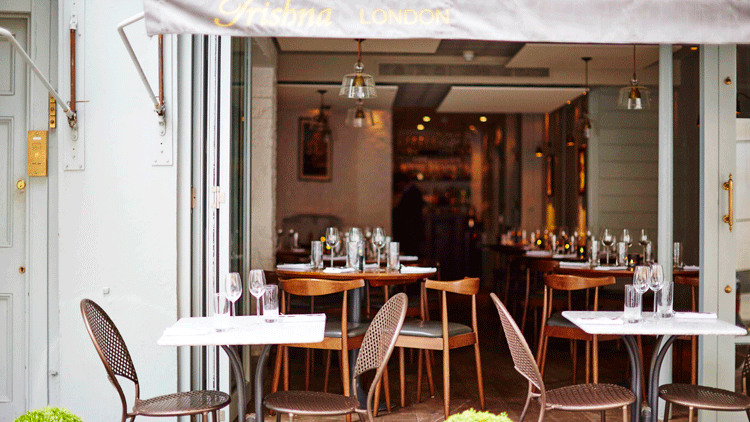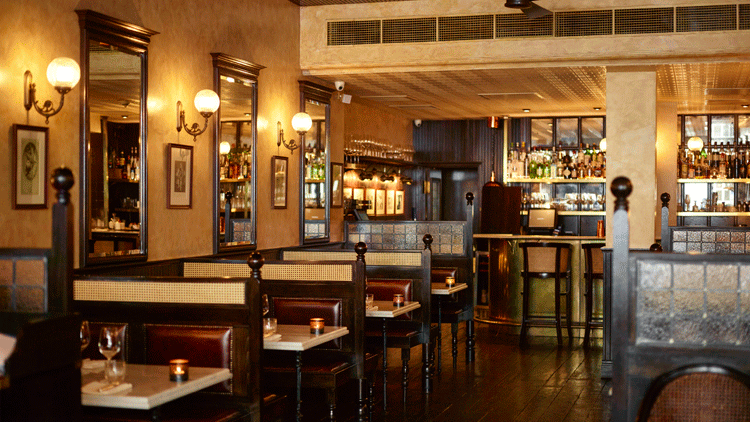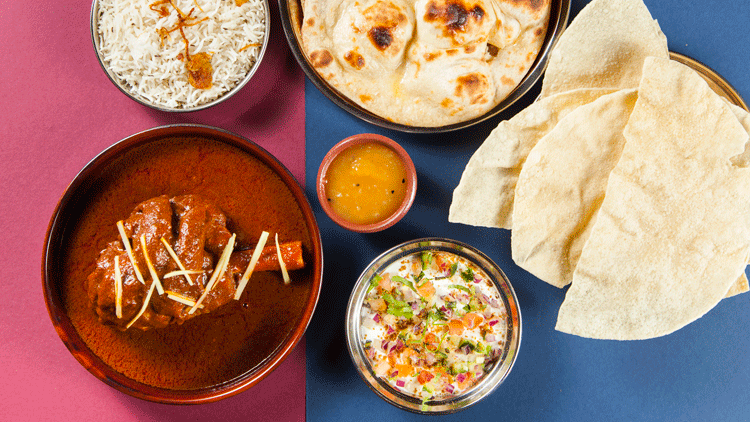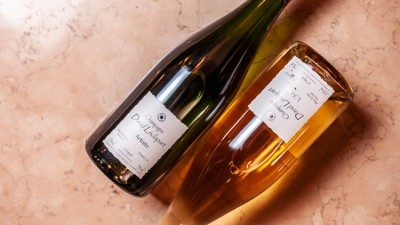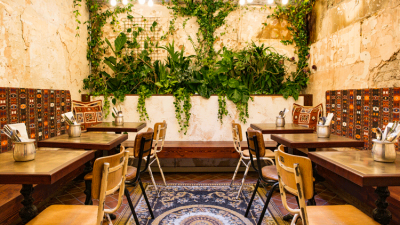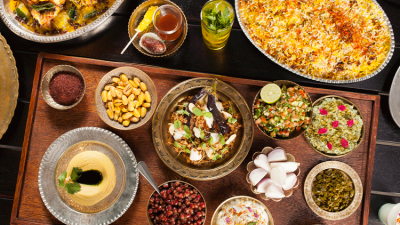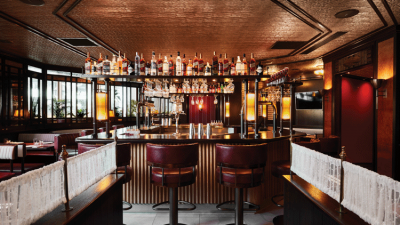Empire builders: How the Sethi siblings have changed the London dining landscape
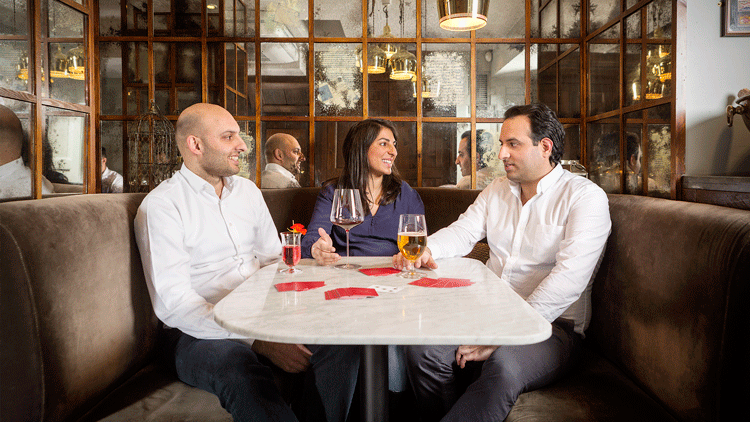
Sunaina Sethi stares out Trishna’s window onto Blandford Street as she considers my question: “What are the advantages of running a restaurant business with your siblings?”. “We can shout at each other,” she replies, matter-of-factly.
“There’s no bullshit,” chips in Jyotin who, at 39, is the oldest of the three Sethi siblings. “There is complete alignment of trust. Our interests are one and the same. Decisions can be made quickly.” Yet this trio – middle child Karam (34) is also seated round the table – always seem to make the right the call. Whether it’s property, concepts, market segments or choosing the best partners, the now 10-strong London restaurant group JKS Restaurants is yet to put a foot wrong.
Another thing that speeds up decision making at the group, which turns 10 later this year, is the siblings’ set roles. Jyotin is CEO, Sunaina (30) oversees the wine and front-of-house ops, and Karam develops restaurant concepts and manages the food side of the business.
There is little overlap and the workload is well balanced. In fact, their skillsets are so complementary it is surprising that the set-up owes more to serendipity than design.
Spicing up the Indian market
Karam founded the business that would become JKS Restaurants – derived from the siblings’ initials – when he was just 24. Jyotin was an investment director for Barclays at the time and helped his kid brother fund coastal Indian restaurant Trishna and also managed its finances off the side of his desk.
The restaurant was a slow burn for the first year or so, but things picked up when Karam fell out with his head chef and took on the kitchen himself. He changed the presentation and dialled up the spicing to the same level found in the dishes served at the Sethis’ family home. A few years later, Trishna won a surprise Michelin star, an accolade it has retained ever since.
Where it all began: The Sethi's Trishna restaurant in Marylebone
Sunaina caught the wine bug while working at Trishna as a student (she originally planned to follow her eldest brother into banking) and obtained a number of wine qualifications. She and Jyotin officially joined the family business around the opening of Gymkhana in 2013.
With its venison biryani, kid goat methi keema with goats’ brains, and absinthe-spiked lassis, the Abermarle Street spot was a landmark Indian restaurant, attracting rave reviews and claiming the top spot on Restaurant magazine’s own National Restaurant Awards in 2014, the first Asian restaurant ever to do so.
The Sethis know how to open and run great Indian restaurants (the JKS Restaurants portfolio also includes the two-strong Hoppers, a mid-market Sri Lankan-inspired restaurant).
But what makes them stand out even more as restaurateurs is their skill in working with up-and-coming talent to create restaurants that are as successful as they are influential (see An eye for talent). In 2012, Karam worked with Sandia Chang and James Knappett to create Fitzrovia hotdog and champagne restaurant Bubbledogs and its fine-dining appendage Kitchen Table.
The former concept looked odd on paper but doubters were soon proved wrong by a precisely executed and great fun restaurant that continues to be busy some six years later. The trio has since helped James Lowe and John Ogier open Lyle’s, in Shoreditch, east London, and backed the Taiwanese-trio behind steamed bun specialist Bao to open three bricks-and-mortar locations – two Baos and the higher reaching Chinatown restaurant Xu.
Launched late last year, JKS Restaurants’ latest restaurant Sabor – a link-up with Spanish back and front-of-house partnership Nieves Barragán Mohacho and José Etura – can already be marked down as another smash hit.
A military operation
Even when working within the confines of an Indian restaurant group, the trio like to confound expectations. Trishna, Gymkhana and Hoppers are stylistically different from each other and are bracingly modern Indian concepts that challenge preconceived notions about what an Indian restaurant should be.
Located in the new Bloomberg Arcade development in the heart of the City of London, their latest restaurant will uphold that tradition. In fact, it is even more of a departure from what has come before.
Inspired by Indian army mess taverns, Brigadiers will be a booze-led bar restaurant with a focus on sport. “There are five USPs. Indian barbecue, beer, whisky, live sport and pool,” says Karam. “There’s hardly anywhere in London where you can go and have good food and good drink and watch sport, let alone somewhere in the City.”
There will be seven different zones at the Bloomberg Arcade site: a bar, a restaurant, a pool room, a separate annexe called the Pot Luck Room, a taproom, a terrace and two private dining rooms. Conceived by Bradley Williams – the same design studio behind Xu – the look is described as art deco. There will also be billiards and classic card games (the Sethis have even designed their own cards) and the restaurant’s reception area will play host to Brigadiers’ resident shoe shine attendant.
Alcohol is at the forefront of the concept with the split between wet and dry sales anticipated to be 50:50. There will be eight to 10 beers on tap and a further 25 to 30 by the bottle. Some of the bookable rooms will also have their own private beer taps, which customers can use on a serve-yourself basis.
Though Sunaina is the drinks specialist, Karam has taken the lead in curating the beer menu, which he describes as global and eclectic. JKS is also working with Derbyshire brewer Thornbridge to create a house beer.
Brigadiers will use a system called Bottoms Up for its draught beer, which, as the name implies fills from the bottom up for a six-second pour. The magnet-enabled technology is more associated with mainstream lagers but, at Brigadiers, it will be used to dispense niche brews.
“The main bit of criteria for the selection of bars in the City of London is ‘how quickly can you get a drink?’ Ten-deep bars are a turn-off so we have developed lots of different ways to get people served more quickly,” says Karam.
To further reduce the queue at the bar, there will be a focus on high-quality pre-mixed cocktails with Brigadiers’ two signature cocktails – nitro espresso martini and smoked butter old fashioned – on draught.
The trio is also working with drinks brand Johnnie Walker to install whisky vending machines that will dispense a selection of spice-infused whiskies. Customers pay for these drinks with a contactless Brigadiers card (it can be topped up online) and dispense the liquor into ice-filled glasses beneath the machine.
The wine list will include some big-name heavy-hitters for bonus-celebrating bankers but, unlike Trishna and Gymkhana, there won’t be a sommelier present to sell them. “All the team will be trained to sell and serve wine,” says Sunaina. “We will focus on smaller producers in the main but, in the City, we also need to offer great vintages from well-known estates. Those people that want to spend big on special bottles will certainly have the opportunity to do that.”
Footy on the telly, ostentatious bottles of wine and whisky vending machines… isn’t this all starting to sound a bit macho? “There’s stuff there for everybody,” says Sunaina. “People said the same thing about Gymkhana (which is loosely based on the gentleman’s clubs of the British Raj) before it opened. But our demographic there is mixed.” “The sport won’t be in your face either,” interjects Karam. “There won’t be commentary blaring away.”
The price point sits a little below Trishna and Gymkhana, but a fair bit above Hoppers. The menu is JKS Restaurants’ largest by some margin, and is split into sections including chhota chatpata (small, spicy plates); mixed grills; steaks, ribs and chops and biryani. The menu gives diners the freedom to mix and match their main course dishes with a wide range of sides and condiments.
A meal at Brigadiers could start with the likes of Kashmiri chilli pork skins; suckling lamb boti skewers; smoked Goan xacuti chilli chicken lettuce cup; goat chapli and bhuna bun kebab before graduating to large plates including Nepali bhutwa lamb ribs; lasooni wood-roasted turbot; or perhaps a brace of pardar mussalum quails.
JKS has not been short of offers for sites, especially at high-profile new developments in the capital and beyond, not least Victoria’s Nova, Battersea Power Station and Oxford’s Westgate. So why Bloomberg Arcade? “There is a huge gap in the market for high-quality Indian food in the Square Mile and the beer and barbecue focus is a good fit for the area,” says Karam. “We also saw how successful Soho House’s The Ned was (which opened last year located very close by on Poultry), which gave us a lot more confidence in entering that market.”
“We also liked the mix at Bloomberg,” adds Jyotin. “There are some good operators there and lots of stuff that is genuinely new. Unfortunately the same can’t be said for all new developments.” With well over 150 covers in total, Brigadiers is JKS’s biggest project to date, and has been made possible by a recently secured funding deal. “It’s a family office rather than a traditional private equity house,” says Jyotin. “It was important for us to find a backer that understands we want to grow in a sustainable way. We want to have a varied portfolio with lots of different styles and price points. We don’t want to suddenly open 50 sites.”
International expansion
The siblings are tight-lipped about their expansion plans in London, but hint strongly that we can expect at least a couple of new restaurants to open before the year is out.
The Sethis have no plans to explore the rest of the UK, but international expansion is high on their agenda. JKS has already helped open a restaurant overseas. In 2014, the Sethis teamed up with Noma-founder Claus Meyer to open Indian restaurant Verandah at The Standard Copenhagen. Now closed, it looks to have taught the trio that consultancy is not their preferred route to market on foreign soil.
“We’re only interested in projects we have full creative control over,” says Karam. “We’ve had a number of approaches from abroad. As soon as we find the right partner, we will do something.
“Eventually, the plan is to have partners in key locations including the US, the Middle East and Asia. But for the next three or four years, our expansion will be focused on London.”
They admit they are feeling the headwinds that are currently buffeting the wider restaurant sector. Jyotin says he takes some comfort from the fact that it is the same for everybody at the moment. “Whether it’s people, property or input costs, there’s nothing we can do about the current macro climate. We will keep our heads down and keep focusing on what we do well, which is premium service, food and drink. The quality of everything we do has to stand out.”
Smash hit: Gymkhana remains among the most influential Indian restaurants in London
By far the biggest worry at the moment is people. “We cannot grow without good staff,” says Sunaina. “As such, we’re investing a lot in training and development.” High property costs are cited as another critical issue for the group. “I’m more hopeful about that one changing soon,” says Jyotin. “Landlords will have to recognise that the rents they have been seeking for the past few years aren’t sustainable. And operators will also soon work out that they can’t make any money from a lot of the deals that are currently being offered.”
Delivering the goods
The Sethis have at least partly circumnavigated property headaches with the four Deliveroo Editions sites for their premium Indian delivery brand Motu, in Battersea, Islington, Canary Wharf and – most recently – Swiss Cottage.
Launched in late 2016, Motu is a typically shrewd venture for the Sethis, who spotted a nascent market for more premium delivered Indian food in well-heeled areas of London. Named after the Hindu slang for ‘fat man’, it offers a familiar curry house food that is devoid of foodie pretension.
It is a play for the mass market, albeit the more premium end. The menu is focused on curry, and the star performer, week on week at every site, is chicken tikka masala, an oft-derided Anglo-Indian dish that would look out of place at any of the group’s current crop of eat-in Indian restaurants.
Staffing has proved easier than at the restaurants in most cases, with many Indian chefs happy to work evenings only in an environment that is – on the whole – less frantic than the group’s company-owned kitchens. While there is no denying that delivery has shaken up the wider restaurant sector, a number of larger businesses have struggled to make enough margin from such partnerships, whether preparing food in store or working out of so-called ‘dark kitchens’.
The Sethis’ secret weapon is a higher price point (most curries are north of £10) and dishes that have been designed for delivery – and delivery only. “To operate in this world successfully, you need to accept that the food won’t be the same as it will be in a restaurant,” says Karam. “We’re not trying to take what we do in Gymkhana and make it work for delivery.”
“Deliveroo needs to charge a high commission on its Editions orders as it has made the initial investment,” says Jyotin. “But the opening costs for us are virtually zero and the operating costs are also low. Performance is largely dictated by Deliveroo’s penetration in a particular area.”
Stand and deliver: dishes from the Sethi's delivery brand Motu
A cheap way to test the water
The Sethis have used Deliveroo Editions as a low-risk way to explore London Zones 2 and 3. Despite a couple of slow starts, the trio are happy with the performance of all locations and will soon look to open company-owned Motu sites that will incorporate an eat-in restaurant.
“Motu has given us the confidence to create a high street restaurant format,” says Karam. “The eat-in sites will have a wider menu but it will still be a familiar curry-house-style experience.” “There needs to be significant demand for delivery in an area for it to work,” says Jyotin. “Eat-in sales complemented by a strong delivery element represents a big opportunity for us.”
Along with the Dishoom restaurant chain, the Sethis can take much of the credit for the capital’s burgeoning new-wave Indian scene. Their restaurants have primed the market for an influx of other forward-thinking, yet authentic, Indian restaurants, not least Kricket, Talli Joe, Tandoor Chophouse, Gunpowder and Madame D.
As such, the trio is now operating in a much busier space. Gymkhana’s success has also intensified competition in Mayfair. More top-end Indians have opened on and around Abermarle Street, not least Jamavar, which was originally fronted by ex-Gymkhana head chef Rohit Ghai, and international export Indian Accent.
The latter restaurant in particular has highlighted the fact that one can’t be the disruptive new kid on the block forever. Just a few doors up from Gymkhana on the former site of Chor Bizarre, the restaurant has attracted a great deal of attention with its progressive yet authentically spiced cuisine.
There are also rumours circulating that restaurant mogul Richard Caring is about to open a high-end Indian. Is saturation in the Indian fine-dining market an area of concern? Apparently not. “What’s happened in Mayfair is amazing. It’s becoming little India. It brings more attention to Indian restaurants generally. We’re not at all worried,” says Jyotin.
“Gymkhana gave people confidence that you can be successful in Mayfair,” says Karam. “Before we opened on Abermarle Street, most people would have said that you can’t open an Indian restaurant in Mayfair because the market is sewn up by the likes of Benares and Tamarind. Yes, there are new people on the scene. But it’s not like all these places are the same. Indian Accent is a completely different style of food to Gymkhana. I haven’t been to the London site but I’ve eaten in the one in New Delhi and I thought it was great.”
One could argue that it’s not the Sethis that need to be worried about the competition, but the reverse. The family has huge reach in the capital and looks set to start shaking up the Indian restaurant market in the suburbs just as they have done in Zone 1.
Brigadiers will be the Sethis’ biggest statement yet and looks set to fit the City market like a bespoke pinstripe suit. After winning the National Restaurant Awards in 2014, Karam told Restaurant that the family wanted to create a restaurant group like no other in London. Mission accomplished.
An eye for talent: What the Sethi siblings look for in a restaurant partner and how the relationship works
The Sethis were among the first to see the value of investing in precocious people and restaurants far earlier than is traditional. Indeed, it could be argued that the siblings kickstarted a mini trend in people with experience and capital backing talent. Other companies taking a broadly similar tack include White Rabbit Fund (Kricket, Andrew Wong, Lina Stores) and Ennismore (Breddos).
While the trio is modest enough to refuse to take credit for the idea, it acknowledges the benchmark for investment has become lower in recent years. “Private equity tends to look for established players, 10 sites is usually the mark,” says Jyotin. “Crucially, we’re also prepared to take start-up risk, which established investors don’t tend to do. We’re happy to invest in the first thing somebody does. To some extent you are throwing the dice, but the advantage is that you can mould a business if you get in at such an early stage.”
The Sethis aren’t looking for the next PizzaExpress, or even a restaurant concept that is scalable. They want to build brands. “Bao is the most obviously scalable concept we’ve worked with, but we have now taken that in a different direction with Xu,” says Karam. “Lyle’s is not a scalable restaurant, but different types of restaurants could be launched off the back of it. The aim is to find teams that want to grow with us and create their own brand, just like we have with our own Indian restaurants. We can help them identify what that will look like.”
So what do the Sethis look for in a partner? “Obsession with food and drink is key. What they do needs to stand out,” says Karam. “We also need to have chemistry and enjoy spending time with them. They need to have the same vision, ambition and energy as us to create something special. If they don’t, it’s not going to work. But, fundamentally, it starts with one question: ‘Do we like their food?’,” adds Jyotin.
All the partner relationships have come about in different ways. Sometimes it’s a coincidence. Bubbledogs and Kitchen Table is a result of the trio getting friendly with Sandia Chang while she was working at Roganic (which was, and now is again, just down the road from Trishna). Sometimes people seek the Sethis out, which is how the trio’s latest partnership with Nieves Barragán Mohacho and José Etura came about.
JKS Restaurants plays a key role in the development of concepts. Perhaps most importantly, it bakes-in financial rigour and operational structure into its partner venues, which allows its partners to focus on the
more creative parts of running a restaurant.
Restaurant partners can also make use of the siblings’ head office team. A full suite of functions are available, including HR, finance, central reservations, property and sales and marketing, although Jyotin indicates that partners can pick and choose which ones they make use of.
There are also some group purchasing arrangements in place. “We don’t dictate or compromise on quality, but if multiple wines work in multiple restaurants, why not? It’s trickier with food, James Lowe’s purchasing requirements at Lyle’s are rather different to Bao’s, for example,” says Sunaina.
But on the less creative, non-food and beverage side of procurement, including EPoS, reservations and cleaning products and services, JKS generally looks to consolidate.
The company is reluctant to talk about the exact terms of each deal but the trio reveal it never takes a minority stake, meaning that it’s either a joint venture or a majority shareholding. “We have no interest in providing a little bit of cash and being hands-off. That’s not the idea,” says Jyotin. “We want to work closely with our partners to shape their business and add value to it.”
